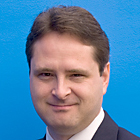Back to Digital Preservation Pioneers
 Martin Halbert, dean of libraries at the University of North Texas, has first-hand knowledge that institutional collaboration is essential for digital preservation. He has collaborated on several successful and influential projects throughout his career, including the Transatlantic Slave Trade Database (external link), Southcomb (external link) and the MetaArchive (external link) cooperative.
Martin Halbert, dean of libraries at the University of North Texas, has first-hand knowledge that institutional collaboration is essential for digital preservation. He has collaborated on several successful and influential projects throughout his career, including the Transatlantic Slave Trade Database (external link), Southcomb (external link) and the MetaArchive (external link) cooperative.
Halbert has always moved freely between the sciences and humanities; his education is in philosophy, chemical engineering and librarianship. In the 1980s, he interned at the IBM library in Austin and used their advanced computer system for mediated searches for researchers worldwide. That experience influenced Halbert's ideas about the potential for computer systems and networked information in public libraries.
An avid science-fiction fan, in 1992 Halbert wrote "Knowbot Explorations in Similarity Space" (external link) about automated search tools in the future (2010) that gather information from networked databases and graphically display the results as holograms. Though there may not be as much eye candy in today's technology as Halbert imagined in 1992, many of the functions he envisioned are now common, including easy access to web-based databases and query results displayed in graphics.
As Halbert's career advanced, teamwork became a theme that ran throughout all his projects. He became adept at figuring out commonalities in goals and desires among different groups and pulling together the technical staff, researchers and users.
With the Transatlantic Slave Trade Database, for example, Halbert worked with historian David Eltis, a fellow professor at Emory University, to unify all available scholarly data on five centuries of worldwide slave trade and make that data openly available online. They mobilized researchers from around the world to work out how to organize the data so that users from different countries could analyze it in a consistent, uniform way. The result is a web-based tool through which users can study historic records about individual voyages, run statistical analyses, display ships' ports geographically and filter information in a variety of ways.
Halbert feels that his most influential project to date is the MetaArchive, which has become a model for institutions working jointly in digital preservation. "We have been running an effective, low-cost, high-impact distributed digital preservation network since 2004," said Halbert.
The idea grew from a brainstorming session Halbert held with other institutions. He found that they all shared an anxiety about digital preservation. Everyone understood that the challenge was too big for any one institution to deal with but they weren't sure what to do about it. The one simple thing they agreed on as a cooperative – that could be immediately useful – was that they needed a mechanism to back up each other's content in a distributed way that would be immune to data loss.
Prior to that session, Halbert had worked with Vickie Reich and he saw a great potential for LOCKSS. "I always had it in my head that the LOCKSS approach to preserving information in a distributed way – the original LOCKSS network was aimed at electronic journal content – could be adapted to the preservation of digital archives that individual institutions were creating."
Six institutions formed the MetaArchive cooperative with the goal of distributing collections in a way that could be replicated by other groups of institutions. Essentially, the MetaArchive formalized an approach that is mutually beneficial to everyone in the cooperative. The method is inexpensive and reliable and serves as a model for other consortia of institutions. Halbert said that MetaArchive helps universities maintain their own digital collections instead of outsourcing the collections.
In October 2009, Halbert assumed the position of Dean of Libraries and Associate Professor at UNT. He will continue his association with the MetaArchive cooperative and he intends to bring UNT in as a MetaArchive member.
Moving to UNT is a return home for Halbert and an opportunity to contribute to Texas's advances in digital preservation. "I'm a Texan," he said, "and I'm really looking forward to getting back to Texas and starting to work at building up and being part of the collaborative environment among all the academic and research libraries." Among the incentives that drew him to UNT, he cites UNT's inspirational work in digital preservation – most notably of Cathy Hartman and the Cybercemetary – and newspaper digitization.
Halbert said that it is a great time for digital preservation in the state of Texas and he's looking forward to fostering partnerships. He said, "There is great strength in collaboration. That's the real opportunity at UNT. Texas is a great sprawling state and you can mobilize a lot of energy if you get the right people in the room and pulling in the same direction. The sky's the limit as to what you could do."
